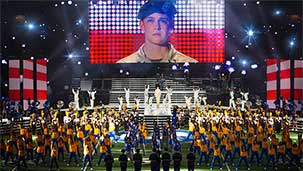While mulling over Billy Lynn’s Long Halftime Walk, the word ‘choreographed’ kept popping into my head. It made me think back to the dance lessons I took when I was a kid. When learning a routine, there was always a point at which I had performed the steps so many times I was dancing on autopilot, no longer thinking about what I was doing nor putting all that much care into it, just as long as I got it right enough that my teacher wouldn’t give me a hard time. The characters in Ang Lee’s film seem bound to a sort of choreography in much the same way; be it the soldiers on a PR tour, or the public that can’t thank them enough for their sacrifices.
On the surface, the garish explosion of Americana is hard to stomach. The film is a stone soup of every symbol of American jingoism you can think of: football, troops in uniform, Old Glory, cheerleaders, to name a few. The script is chock-full of tired, by-rote lines about duty, bravery, and gratitude for the troops’ sacrifice, all delivered in an almost mocking tone by the actors.
It would be too simplistic to say Billy Lynn accuses its characters, and by extension, its audience, of being false in their support for veterans or members of the armed forces. In fact it goes further, calling out a certain hypocrisy in which we go through the motions of ‘supporting the troops’ while ignoring the messier, more difficult aspects of their experiences. It joins films like American Sniper and Flags of Our Fathers in using stories of disillusioned and traumatized soldiers readjusting to civilian life to examine the hollowness of that much-performed phrase, “Support our troops.”
Ultimately, Billy Lynn is not simply about whether the admiration and gratitude for Billy and the rest of his unit are genuine. Instead, it picks apart the various displays of ‘support’ for these men in uniform, framing it as an unbalanced, selfish exchange wherein support for the troops isn’t so much about giving something to them as it is about wanting something from them. Every exchange Billy and his fellow soldiers have with civilian characters is framed this way: someone thanks them, and tells them how brave they are, and then asks them for something, callously pushing them to recount and relive battlefield trauma to provide vicarious thrills, to make themselves feel noble and generous for supporting the troops. The insensitivity shown to Billy and his unit goes from amusingly awkward to straight-up heartbreaking, culminating in a halftime pyrotechnics display that takes the men right back to the battlefield.
There are moments when Billy and his sergeant attempt genuine, unchoreographed expression, desperation creeping around the edges of their features as they try to connect to people with the unadorned truth of their experience, their fear, and their doubt. These attempts are received with discomfort and disappointment; no one likes the guy who falls out of step while everyone else is going through the motions in perfect synch with empty stage grins plastered across their faces. No one wants inglorious truth when we can drape it in red, white, and blue bunting and parade it around a football field with Beyoncé. As a pushy Hollywood producer tells Billy’s unit, fresh from a horrific battle and burying one of their own, they make people feel good about America again. Lee brings his film to a bleak, unflattering conclusion; it isn’t about thanking the troops for their service, it’s about how that show of gratitude makes us feel about ourselves.
Best,

Nat
Top rated U.S. Army boots for long halftime walks and Iraqi field patrols.
Check out this DC&C Special Tie-in today.






